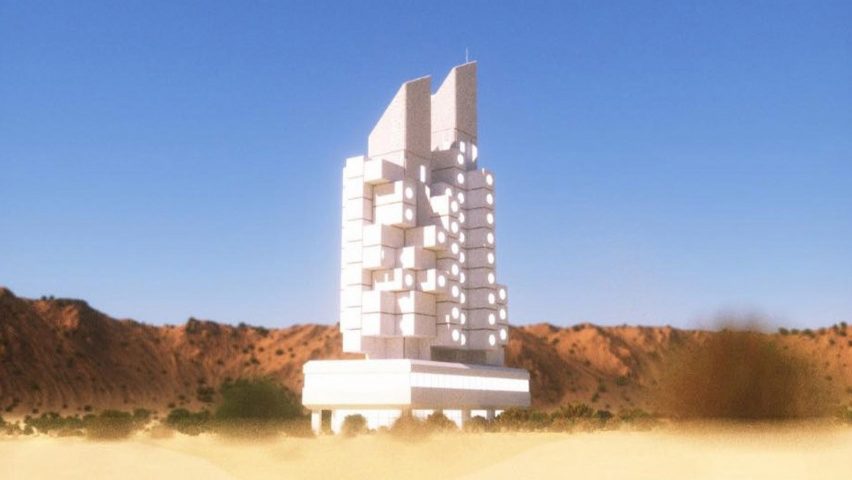The Nakagin Capsule Tower in Tokyo could soon be replicated in both real space and the metaverse, as its original architect Kisho Kurokawa's studio is auctioning the rights to rebuild it.
Tokyo-based Kisho Kurokawa Architect and Associates (KKAA) and Japanese investment company Laetoli are currently selling the rights to reconstruct the tower on OpenSea – a marketplace based on non-fungible token (NFT) technology.
There are two ongoing NFT sales, one which will allow a winning bidder to rebuild Kurokawa's Nakagin Capsule Tower anywhere in the world, and another to construct a version of it in the metaverse.
Launched on 22 July, the auction responds to the demolition of the iconic Japanese housing block, which is underway in Tokyo's Ginza neighbourhood.
The Nakagin Capsule Tower was built in 1972 as part of Japan's metabolist movement and featured 140 prefabricated tiny capsule homes that were bolted onto two concrete towers.
Video footage shot by Dezeen in April shows construction workers starting to dismantle these modular capsules, due to the building's ageing structure.
According to KKAA, the sale of its reconstruction rights aligns with the theories of metabolism, which were pioneered by Kurokawa and championed adaptability.
"The main idea of metabolist architecture was to rethink society using architecture as a tool for potential change, speculating how buildings can change, grow, and evolve," KKAA told Dezeen.
"By entering the digital space, the metabolism theory can continue to evolve and reflect society today and in the future."
Laetoli, KKAA's collaborator on the project, operates a company called Kabuki X that exists to preserve Japanese culture and architecture for future generations in real and virtual spaces.
"We hope that this auction will ensure that this historical masterpiece will be rebuilt somewhere in the world by those who value the idea of metabolism and are able to optimise his design to enhance society," reflected its director Yoshitaka Kataoka.
NFTs, or non-fungible tokens, are digital certificates of authenticity and ownership that can be assigned to physical and digital assets.
Similarly to a cryptocurrency transaction, each token is individually minted on a blockchain and allows the associated asset to be bought, sold and collected.
To host the auction, an accurate digital model of the tower has been created by international architecture studio BDP, which was approached for the project by KKAA and Laetoli.
Using archival content and drawings supplied by KKAA, BDP created the model of the tower's architecture, structure and services on Autodesk's Revit software.
The studios also utilised Autodesk's BIM360 collaboration software, enabling them to view the model and comment on it across their studios in Tokyo and the UK.
After the sale, BDP's CAD data and model will be supplied to the winning bidders to allow them to construct the Nakagin Capsule Tower in real space and the metaverse.
For buyers of rights for metaverse construction, there will be no restrictions on design rights.
This means buyers will be able to alter the tower's design in virtual space and have complete creative freedom over its colour, size and function.
In real space, KKAA believes the tower's blueprint could be used for everything from housing in overcrowded cities to providing temporary shelters in places hit by natural disasters.
However, KKAA will require purchasers to "show [it] their schemes and get [its] approval in advance" when rebuilding in real space.
"Initially, we are in the position that we don't restrict the purchaser on the recreations of the building unless the recreations will be detrimental to the reputation of KKAA and Nakagin Tower," the team explained.
"The purchaser can change the numbers of the capsules or towers, whatever," KKAA continued. "But physically the recreations must be built under the building regulations in each country."
KKAA added that while there is only one auction for both the real space and metaverse rights, purchasers can lease or sell them to others. This means a number of iterations of the tower could be built.
The starting price for the auction has not been disclosed.
Another attempt to preserve the Nakagin Capsule Tower in digital space is being made by Japanese digital consultancy Gluon, which is creating an augmented reality model of the building by combining data from laser scanning with 20,000 photographs.
As part of the project, Gluon has laser-scanned the entire building.
Some of the original tower's capsules are also being protected by residents and conservation groups. This includes the Nakagin Capsule Tower A606 Project, which is restoring and modifying the capsule numbered A606.
The group plans to transform one of the pods into a "mobile capsule", which it said will honour "Kurokawa's concept of 'architecture in motion'" and adaptability.
The visuals are courtesy of BDP unless stated.

